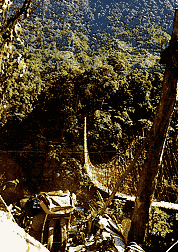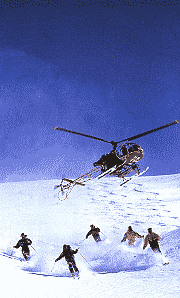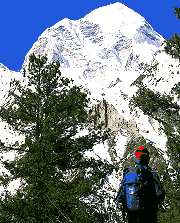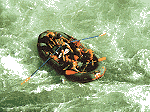|
|
| Trekking / Adventure |
| Jammu & Kashmir
Garwhal
Darjeeling & Sikkim
Satpura Hills
Nilgiris
Adventure Sports
|
Himachal Pradesh
Kumaon
Aravalli Hills
Western Ghats
General Imp Info
|
TREKKING
 Trekking has come a long way since the days of tedious journeys on foot. Today, it conjures up visions of the spectacular northern and eastern Himalayas, the mist-strewn western ghats or the blue tranquillity of the Nilgiri hills. India is the ultimate destination for a trekking holiday, offering everything from short and easy excursions to the long challenges on the snowy peaks. Trekking is comparatively undemanding, and only requires the stamina to walk long hours and the mental agility to adapt to an ever-changing landscape. And the landscape is indeed spectacular. The trekker will encounter rugged hills and mountains, green slopes carpeted with wild flowers and ice cold streams gurgling over boulders and ground pebbles. Far above in the clear blue sky, eagles wheel and bank while golden orioles, scarlet minivets and white-cheeked bulbuls pierce the pure air with their sweet cries. To take a trek in India is to rediscover the awesome majesty and beauty of nature. The highest mountain range on earth – the Himalayas - forms 3500 kms of India’s northern and eastern frontiers. The spectacle of the snow capped peaks, glaciers, pine forested slopes, rivers and lush meadows of wild flowers cannot be equaled. Peninsular India offers natural beauty of another kind, clothed in green woodland and fragrant orchards. What follows is a description of the important trekking areas in India and there is also a section devoted to general trekking and adventure tourism information. Trekking has come a long way since the days of tedious journeys on foot. Today, it conjures up visions of the spectacular northern and eastern Himalayas, the mist-strewn western ghats or the blue tranquillity of the Nilgiri hills. India is the ultimate destination for a trekking holiday, offering everything from short and easy excursions to the long challenges on the snowy peaks. Trekking is comparatively undemanding, and only requires the stamina to walk long hours and the mental agility to adapt to an ever-changing landscape. And the landscape is indeed spectacular. The trekker will encounter rugged hills and mountains, green slopes carpeted with wild flowers and ice cold streams gurgling over boulders and ground pebbles. Far above in the clear blue sky, eagles wheel and bank while golden orioles, scarlet minivets and white-cheeked bulbuls pierce the pure air with their sweet cries. To take a trek in India is to rediscover the awesome majesty and beauty of nature. The highest mountain range on earth – the Himalayas - forms 3500 kms of India’s northern and eastern frontiers. The spectacle of the snow capped peaks, glaciers, pine forested slopes, rivers and lush meadows of wild flowers cannot be equaled. Peninsular India offers natural beauty of another kind, clothed in green woodland and fragrant orchards. What follows is a description of the important trekking areas in India and there is also a section devoted to general trekking and adventure tourism information.
|
| Top |
JAMMU & KASHMIR
J & K is India’s northernmost state, and one of the best known places for trekking. It is an extravagantly beautiful land of flower-spangled meadows, wild orchards, spectacular coniferous forests, icy mountain peaks and clear streams and rivers. The capital, Srinagar, is the base for many treks, notable among them are the treks to the blue Zabarwan Hills and Shankaracharya Hill. The three other main bases in J & K are Pahalgam(100 km from Srinagar) in the Lidder Valley, the base for treks to sacred Amarnath, Aru, Lidderwat and the glacial lakes of Tarsar and Tulian; Gulmarg (51 km from Srinagar), from where one can trek to the crystal tarns of Apharwat and Alpather, the upland lakes of Vishansar and Gangabal and the Thajiwas Glacier; and Sonamarg, in the Sindh Valley, the base for treks into the surrounding mountains. Srinagar is also the roadhead for trips into the arid plateau of Ladakh, a country of perpetual drought, the home of wild asses and yaks, with high ranges that have some of the largest glaciers in the world outside the polar regions. Leh, the divisional capital, lies on an ancient silk route and is the base for spectacular treks across this remarkable landscape. Further south, excellent treks can be made in the vicinity of Jammu, the railhead to the Kashmir Valley. The three main centres are Kishtwar, Doda and Poonch.
|
| Top |
HIMACHAL PRADESH
 The landscape of this province ranges from the barren rocks and raging torrents of the valleys of Spiti and Lahaul in the north to the southern orchard country of Kangra and Chamba. Treks from Manali include the Bhaga river to Keylong, and then on to the Bara Shigri glacier or over the Baralacha Pass to Leh. Kulu, in the centre of the province, is set in a narrow valley between the towering Himalayas and the river Beas, and is famous for its temples and religious festivals. Treks from here traverse terraced paddy fields and on to remoter regions of snow and ice. The view from the Rohtang Pass is particularly spectacular. The town of Dharamsala, in the Kangra Valley area, is the base for treks into the Bharmaur Valley over the Indrahar Pass, and on to still higher passes beyond. Chamba, situated on a mountain above the Ravi River, is named after the fragrant trees which flourish around its richly carved temples. Treks from the nearby town of Dalhousie lead to the glacial lake of Khajjiar and to the passes of Sach and Chini. Simla, the summer capital of the British, is a high hill station and the base for treks into Kulu Valley via Jalori Pass and on to the Kalpur and Kinnaur Valleys The landscape of this province ranges from the barren rocks and raging torrents of the valleys of Spiti and Lahaul in the north to the southern orchard country of Kangra and Chamba. Treks from Manali include the Bhaga river to Keylong, and then on to the Bara Shigri glacier or over the Baralacha Pass to Leh. Kulu, in the centre of the province, is set in a narrow valley between the towering Himalayas and the river Beas, and is famous for its temples and religious festivals. Treks from here traverse terraced paddy fields and on to remoter regions of snow and ice. The view from the Rohtang Pass is particularly spectacular. The town of Dharamsala, in the Kangra Valley area, is the base for treks into the Bharmaur Valley over the Indrahar Pass, and on to still higher passes beyond. Chamba, situated on a mountain above the Ravi River, is named after the fragrant trees which flourish around its richly carved temples. Treks from the nearby town of Dalhousie lead to the glacial lake of Khajjiar and to the passes of Sach and Chini. Simla, the summer capital of the British, is a high hill station and the base for treks into Kulu Valley via Jalori Pass and on to the Kalpur and Kinnaur Valleys
|
| Top |
GARWHAL
Set high in the Garhwal Himalayas, this region (which is sometimes referred to as the Uttarakhand) abounds in myths and legends of the Indian Gods. It is here that one can see Gaumukh, the source of the life-giving Ganga. Indeed, many of the great rivers of northern India have their headwaters in this land of lush valleys and towering snow-ridged peaks. Mussoorie, a hill station much used by the British to escape the searing heat of the plains, is also an excellent base for treks into the Gangotri and Yammounotri valleys.Gaumukh can also be reached from here. Another hill station,Rishikesh, is situated just north of the sacred city of Hardwar, and is the base for treks to another holy shrine, Badrinath. A particularly rewarding stop en route to Badrinath is the breathtaking Valley of Flowers, which is in full bloom in August. Other destinations include Hemkund lake, Mandakini Valley and Kedarnath which is one of the twelve Jyotirlings of Lord Shiva with a beautiful temple.
|
| Top |
KUMAON
This region stretches from the Himalayas to its north to the green foothills of Terai and Bhabar to its south, consists of the three northeastern Himalayan districts of Uttar Pradesh, all of which are particularly rich in wildlife. One of the major trekking centres is Almora, an ideal base for treks into pine and rhododendron forests with dramatic views of stark, snowcapped mountains. The Pindiri Glacier and the valley of Someshwar can be reached from here. Another base is Nainital, a charming, orchard-rich hill station. It is the base for short treks to Bhimtal, Khurpatal and Binayak Forest. Ranikhet, with a magnificent view of the central Himalayas, is the base for treks to Kausani. The view from here is one of the most spectacular in India, and inspired Mahatma Gandhi to pen his memorable commentary on the Gita-Anashakti Yoga.
|
| Top |
DARJEELING & SIKKIM
 Dominated by the five summits of mighty Kanchenjunga, the Darjeeling and Sikkim area of the eastern Himalayas is alsoa region of gentle hills and dales, pine forests, turquoise lakes and burbling streams. One of the best ways to arrive here is by the "toy train" from New Jalpaiguri. The town of Darjeeling is the home of the Everest climber Tenzing Norgay. The Himalayan Mountaineering Institute is also in Darjeeling. The place is also a base for both low- and high-level treks. Trekking destinations include Tiger Hill (offering a breathtaking view of the Himalayas), Sandakphu and the peaks of Phalut, Sandakphu, Singalia and Tanglu. To the north, Sikkim is a wonderland of ferns and flowers, birds and butterflies, orchids, bamboos, forests of cherry, oak and pine, all set among sweetly flowing rivers, terraced paddy fields and blazing rhododendrons. Deep in the interior are Sikkim’s famous monasteries, their white prayer flags fluttering against a deep blue sky. Its capital is Gangtok, a convenient base for treks to the north and east of the region, to sacred Yaksum, Pemayangtse and the mountains near Bakkhim and Dzongri Dominated by the five summits of mighty Kanchenjunga, the Darjeeling and Sikkim area of the eastern Himalayas is alsoa region of gentle hills and dales, pine forests, turquoise lakes and burbling streams. One of the best ways to arrive here is by the "toy train" from New Jalpaiguri. The town of Darjeeling is the home of the Everest climber Tenzing Norgay. The Himalayan Mountaineering Institute is also in Darjeeling. The place is also a base for both low- and high-level treks. Trekking destinations include Tiger Hill (offering a breathtaking view of the Himalayas), Sandakphu and the peaks of Phalut, Sandakphu, Singalia and Tanglu. To the north, Sikkim is a wonderland of ferns and flowers, birds and butterflies, orchids, bamboos, forests of cherry, oak and pine, all set among sweetly flowing rivers, terraced paddy fields and blazing rhododendrons. Deep in the interior are Sikkim’s famous monasteries, their white prayer flags fluttering against a deep blue sky. Its capital is Gangtok, a convenient base for treks to the north and east of the region, to sacred Yaksum, Pemayangtse and the mountains near Bakkhim and Dzongri
|
| Top |
ARAVALLI HILLS
The Aravallis, remnants of the oldest mountain range in the subcontinent, resemble outcroppings of rocks rather than mountains and are virtually barren except for thorny accacias and date palm groves found near the oasis. The main resort in the region, Mount Abu, stands on an isolated plateau surrounded by rich green forests. A variety of one day treks are available from here, all of which afford the opportunity to visit some of the remarkable temples in the region. Notable among these is the Arbuda Devi Temple, carved out of the rock face and offering spectacular views across the hills. Guru Shikhar, Gaumukh and Achalgarh Fort can all be reached during one day treks from Mount Abu
|
| Top |
SATPURA HILLS
This range straddles central India and forms the northern border of the Deccan. The main hill station is Pachmarhi, a beautiful resort of green forest glades and deep ravines overlooking red sandstone hills. Short treks can be made from here to the Mahadeo Dhupgarh peaks
|
| Top |
WESTERN GHATS
The Western Ghats run parallel to the west coast of India from the river Tapti to the southernmost tip of the subcontinent. The mountains are lush and thickly forested and although they cannot claim to have the awesome majesty of the great Himalayas the region has many features of great natural beauty. The hill station of Mahabaleshwar, lies in the north of the range, and the highest in the area and is considered an ideal base for trekkers. Other popular bases and trekking destinations include Lonavala, Khandala, Matheran and Bhor Ghat, a picturesque region of waterfalls, lakes and woods. Further south in Karnataka is Coorg, perched on a green hilltop and surrounded by mountainous countryside. Madikeri is a take-off point for treks in this region. The Upper Palani hills in Tamil Nadu are an offshoot of the Ghats, covered in rolling downs and coarse grass. Kodaikanal is the attractive base for two short treks to Pilar Rock and Green Valley View. Courtallam, also in Tamil Nadu, is surrounded by dense vegetable, coffee and spice plantations; rich in wildlife, it is also one of the most beautiful areas of the Western Ghats.
|
| Top |
Nilgiris
The gentle heights of southern India, a world away from the daunting Himalayas, are friendly and approachable with treks made simple by moderate altitudes and a pleasant climate. Sometimes known as the Blue Mountains because of their lilac hue, they are noted for their orange orchards, tea gardens, wooded slopes and tranquil lakes. There are three major trekking centres here: Ootacamund (popularly known as ooty) is the base for walks to the Wenlock Downs, the Kalahatti Falls and Mudumali Game Sanctuary; Coonor, conveniently situated for Drogg’s Peak and Lamb’s Rock; and Kotagiri, the oldest of the three, whose sheltered position enables it to offer many shaded treks to explore the tranquility of the Nilgiris
|
| Top |
GENERAL TREKKING INFORMATION, ESSENTIAL EQUIPMENT Tent, sleeping bag, foam/inflatable mattress, rucksack, umbrella (doubles as a walking stick), sunhat, dark glasses, toilet requirements.
Clothing : Wind-proof jacket, down jacket, trousers, shirts, woolen pullover, woolen underwear (for high altitudes), gloves.
Footwear : Be sure to take a light, flexible and comfortable pair of trekking shoes (two pairs should be taken for longer treks) and at least three pairs of woolen socks. Use talc to keep feet dry.
First-aid kit : Sterilised cotton wool, bandages, antiseptic ointment, water purification tablets, pills etc for common ailments (such as cough, cold, headache, stomach ache etc), eye lotion, anti-sunburn cream, a hot stimulant for emergencies, morphia salt tablets to avoid cramps.
Miscellaneous : Torch, thermos/ water bottle, insect repellent, mirror, cold cream, lip-salve, walking stick, spare boot laces, sewing kit, tinned and dehydrated food.
Food and Accommodation : Boarding and lodging is available on all trekking routes
Permits : Trekkers are reminded that it is forbidden to enter Restricted and Protected Areas without correct documentation. Please consult the Tourist Offices before departure or local tourist offices on arrival in India to ascertain what restrictions may apply and what documentation may be required.
Season : This varies from region to region; check with the Tourist Office for further information. In general, the season runs from April to June and September to November. It is possible to undertake treks in the valleys of Lahaul, Pangi and Zanskar and in Ladakh during the rainy season (June to August) as these areas receive minimal rainfall.
Mountaineering : Permission for mountaineering must be obtained from the Indian Mountaineering Foundation, Anand Niketan, Beneto Juarez Road, New Delhi, ND 110021
|
| Top |
ADVENTURE SPORTS
The spectacular variety that one sees in everything in India extends to the range of sporting activities as well. From the ski slopes of Kashmir to the water sports centres of the large beach resorts, whatever the season, you will find a sport to suit your taste. Try driving off from the fist tee of one of the country’s beautiful golf courses, or casting for trout or salmon in the clear mountain rivers of the north. Or perhaps watch a skillful game of hockey, bet a few Rupees while mixing with the fashionable race-goers at any of India’s elegant racecouses; or combine elements of both by enjoying the spectacle of a game of polo. Hotels and Tourist Offices will be able to supply details of all these and other available attractions.
 River rafting : This is a fairly young sport in India. The snow-fed mountain rivers that run down from the mighty Himalayas make northern India one of the best regions in the world for this sport. Amateurs and first-timers have their choice of quieter waters, but with the promise of a passage through some truly spectacular riverside landscapes. Some rapids hit Colorado 8 (the highest is 10) on the scale, but most are on the 4 to 6 grade. The main regions are Ladakh, Garhwal and the four rivers of Himachal Pradesh River rafting : This is a fairly young sport in India. The snow-fed mountain rivers that run down from the mighty Himalayas make northern India one of the best regions in the world for this sport. Amateurs and first-timers have their choice of quieter waters, but with the promise of a passage through some truly spectacular riverside landscapes. Some rapids hit Colorado 8 (the highest is 10) on the scale, but most are on the 4 to 6 grade. The main regions are Ladakh, Garhwal and the four rivers of Himachal Pradesh
Rock climbing : Delhi is the centre for most rock climbing activity in India, the prime area being Tughlaqabad. Slightly further afield, an excellent place to go rock climbing are the Aravalli Hills (particularly Dumdama, Dhauj and Nuh). Further north, the Manali valley and Rohtang Pass regions of Himachal Pradesh are popular, as are the Chamundi Hills in Karnataka and the Garhwal Himalayas in Uttar Pradesh. Beyond Pune on the Western Ghats the gentle hills form picturesque rock formations and many places are ideal for climbing. For more gentle climbs, the area of Mount Abu and Sariska (Rajasthan)are a good bet. Except the monsoon periods, rock climbing is virtually a year-round activity, and most equipment can be hired locally
Camel safari : An ideal trip for those with time to spare and with the desire to experience the subtle sunset shades of the desert and the solitary magic of the rolling golden sands. Camel safaris are available in the Thar desert, and range from one to fifteen day durations. The best safaris are in the heart of the Thar, in the Jodhpur, Jaisalmer and Bikaner region, and will pass tiny villages and remote trading posts. Another popular area is the Shekhawati region. The safari organisers attempt to recreate the atmosphere of the old caravan journeys; music, traditional food and campfire hospitality are all part of this unique experience. Staff are available for assistance, and all necessary equipment is provided.
Hang-gliding : Another sport which is rapidly growing in popularity, and one which provides an exciting view of the landscape in India. There are clubs in Pune, New Delhi, Bombay, Chandigarh, Shimla, Devlali and Bangalore. Many hang-gliding sites in India (particularly in the Himalayan region) have been highly rated by experts, and the climate of the country gives particularly good thermal soaring effects in the summer months; the monsoons are the only bad period for this sport.
Gliding : There are about a dozen gliding clubs throughout India, but Delhi is the principal centre. Excellent western air disturbances make it possible to glide as far a field as Calcutta from here, although typical flights are less ambitious. Generally, the best seasons are September to November and March to June.
Air Balloons : The main centre for this exhilarating sport is the Balloon Club of India at New Delhi’s Safdarjang. Balloons generally hold from one to ten people and can rise to heights of over 800 feet
Motor Rallying : The topographical diversity of India makes it ideal for road rallies, over anything from desert roads to beaches, hills, mountains and forest tracks. There are many spectacular vintage car rallies and also rallies featuring more modern vehicles that provide a supreme test of a driver’s mastery over both machines and conditions. Principal among these are the Monsoon Rally, the Charminar Challenge and – most demanding of all the Himalayan Car Rally. This rally is usually divided into four legs through Himachal Pradesh and Uttar Pradesh.
Skiing : Fast becoming a popular sport. Facilities are offered by some resorts in the north of the country. The two major ones are Gulmarg in Kashmir and Kufri in Himachal Pradesh, set in some of the most beautiful mountain landscape in the world.
Fishing : Both inland and sea fishing is available, with possible catches ranging from the shark, karkara and gohol in the deep waters of the Indian Ocean or the Bay of Bengal to trout and mahseer in the clear rivers of the north. Tackle can often be hired from local fishing authorities. Check with the local tourist office for details of seasons and licenses
Golf : Enthusiasts will find many courses open to visitors throughout India. You can enquire at major hotels for details of temporary membership. The Calcutta Amateur Golf Championships attracts large numbers of serious golfers in the east; the standards are high, but for those interested, temporary membership is available from the
Other sports include horse-riding in hill stations and tennis and squash, available in hotels and private clubs. Most large hotels have swimming pools, and there are facilities for a wide range of water sports including sailing, rowing and water skiing at seaside resorts. The Andaman Islands in particular are noted for their scuba diving. Spectator sports include football, interest in which is increasing, while Polo and hockey are sports at which the Indians have long excelled, winning many Olympics Gold medals. Whatever your interest, whatever your pleasure, India can entertain and thrill as much with her sports as with her landscape, culture and beauty.
|
| Top |
|
|
